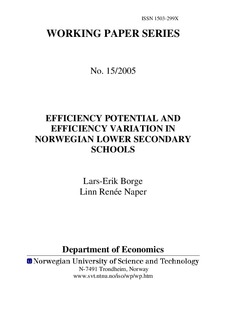| dc.contributor.author | Borge, Lars-Erik | nb_NO |
| dc.contributor.author | Naper, Linn Renée | nb_NO |
| dc.date.accessioned | 2014-12-19T14:31:46Z | |
| dc.date.available | 2014-12-19T14:31:46Z | |
| dc.date.created | 2006-10-02 | nb_NO |
| dc.date.issued | 2005 | nb_NO |
| dc.identifier | 126049 | nb_NO |
| dc.identifier.uri | http://hdl.handle.net/11250/267083 | |
| dc.description.abstract | The paper performs an efficiency analysis of the lower secondary school sector in Norway. The efficiency potential is calculated to 14 percent based on a DEA analysis with grades in core subjects (adjusted for student characteristics and family background) as outputs. The analysis of the determinants of efficiency indicates that a high level of municipal revenue, a high degree of party fragmentation, and a high share of socialists in the local council are associated with low educational efficiency. The negative effects of the share of socialists and party fragmentation seem to reflect both higher resource use and lower student performance. | nb_NO |
| dc.language | eng | nb_NO |
| dc.publisher | Institutt for samfunnsøkonomi | nb_NO |
| dc.relation.ispartofseries | Working Paper Series, 1503-299X; 2005:15 | nb_NO |
| dc.title | Efficiency potential and efficiency variation in Norwegian lower secondary schools | nb_NO |
| dc.type | Research report | nb_NO |
| dc.contributor.department | Norges teknisk-naturvitenskapelige universitet, Fakultet for samfunnsvitenskap og teknologiledelse, Institutt for samfunnsøkonomi | nb_NO |
